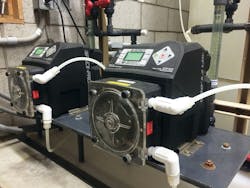Mammoth Lakes is a resort town nestled in the Sierra Mountain Range in North Eastern California, USA. Known for winter and summer tourist activities, the town experiences a high seasonal demand on its water resources during tourist influxes.
The towns’ drinking water resources consist of nine wells, and fresh water from Lake Mary, situated above the town. Mammoth Community Water District developed two Ground Water and one Surface Water treatment stations to purify the drinking water.
Arsenic is present in the well water, and the Water District needed a means of removing the arsenic to render the water safe for human consumption.
Mammoth Water District utilizes Sodium Hypochlorite (NaClO) and Ferric Chloride (FeCL₃) in a multi-step arsenic removal process. Injection of these chemicals into the raw ground water transforms the arsenic molecules into a precipitate that can then be filtered out of the water.
Water in one of the wells requires a higher concentration of chemical for optimum arsenic removal. Operators segregated this well during treatment which lead to an overall reduction in chemical consumption and related cost. The treated water could then be re-integrated with that of the other wells.
The Water District installed ProSeries-M® M-3 Peristaltic metering pumps to assist in the treatment of the water, and removal of the arsenic.
Originally, the Well Stations utilized Solenoid Style pumps and found the off-gassing nature of liquid NaClO created vapor lock in the pumps. The solution to this problem was a peristaltic design. The ProSeries-M® peristaltic metering pumps allow the excess gas accumulation to be pumped through the tubing, while also maintaining smooth, accurate and constant flow rate with no potential for vapor lock.
Additionally, when solenoid diaphragm pumps were used, the chemical tank required constant maintenance. If fluid volume levels fell below the level of the pump head, the pump became susceptible to suction lift errors, including loss of prime. With the ProSeries-M®, the pump head serves as a check valve: no matter the level in the chemical tank, the peristaltic pump has reliable suction lift, and will not lose prime.
Utilizing the pumps 4-20mA input, the Water District was able to set the desired dosage in the SCADA, based on the incoming flow of water to the plant. The ProSeries-M is able to handle fluctuations in feed demand, keeping chemical injection at a consistent ratio.
The ProSeries-M® pump includes the built in, patented Tube Failure Detection system (U.S. Patents 7,001,153 and 7,284,964). The TFD System can detect tube failure and automatically shut off and energize a relay, permitting communications with external equipment, such as an alarm or a SCADA system. The chemical must be cleaned from the pump head before the pump will restart.
ProSeries-M® M-3 is capable of feed rates to 33.3 GPH/126 LPH, with a 10,000:1 turndown ratio. Maximum pressure rating is 125 PSI / 8.6 Bar. The M-3 peristaltic metering pumps successfully assisted in the resolution of water treatment challenges at Mammoth Community Water District.
Editor's Note: Scranton Gillette Communications and the SGC Water Group are not liable for the accuracy, efficacy and validity of the claims made in this piece. The views expressed in this content do not reflect the position of the editorial teams of Water & Wastes Digest, Water Quality Products and Storm Water Solutions.
